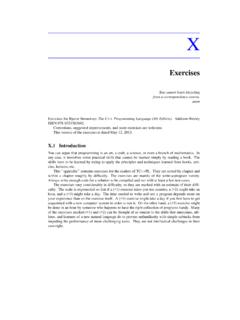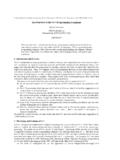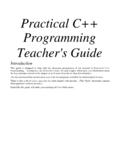Transcription of PPP Style Guide - Bjarne Stroustrup
1 PPP Style Guide Stroustrup 10/7/2011. PPP Style Guide Bjarne Stroustrup ~bs Introduction All major real-world software projects have a house Style ( coding Guide -lines , project standard or whatever they are called) to ensure clarity and consistency. This can be a nuisance because no Style is perfect, different projects have different styles , and we'd rather just write what looks good on the day.. However, professionals follow the approved Style for a project ( ). This document outlines the Style we use with Programming: Principles and Practice using C++ (sometimes referred to as PPP ). References, such as , point to sections of PPP. More examples can be found in the model solutions to exercises posted on the web (though the comments on those can be a bit chatty). Stick to the simple rules outlined here.
2 It'll help you to read your own code and that of others and keep you out of some minor programming problems. Your TAs are encouraged to take off points for egregious departures from this Style Guide (as well as to gently Guide you to improve your Style you won't master all immediately). Code as if you really mean it. Most real-world code lives for a long time (years or decades) and is read and modified repeatedly by others. Make their job more manageable by using good Style . Remember, one of those other people might be you. There can be no one true Style that is best for everybody everywhere, but what we recommend here is better than anything a novice can cook up in a hurry. This is not a comprehensive Style Guide for major industrial use, but it is still better than some we have seen claimed to be that.
3 Naming See for a discussion. Use a single capital letter to start a type name, Table and Temperature. Names of non-types are not capitalized, x and var. We use underscores for multi-part names, initial_value and symbol_tbl. Use meaningful names. Don't overuse acronyms. Don't use excessively long names, such as remaining_free_slots_in_symbol_table. The length of a name should be roughly proportional to the size of its scope ( ). Be careful when using letters and digits that are easily misread: 0Oo1lL. Don't use ALL_CAPS. C++ identifiers are case sensitive, so Val is different from val. ~1~. PPP Style Guide Stroustrup 10/7/2011. Indentation Indent as done in the book. For example: // if statement: if (a==b) {. // . }. else {. // . }. // loop: for (int i=0; i< (); ++i) {. // . }. // Switch statement: switch(a) {.}
4 Case a: // . break;. case b: // . break;. default: // .. }. // function: double sqrt(double d). {. // . }. // class or struct: class Temperature_reading {. public: // . private: // . };. Note the placement of the braces ({ and }). We consider that placement significant. I use tab characters for indentation. This can be a problem when changing editors. As long as you are consistent, you could use spaces for indentation instead (with a minimum of 3 spaces per indentation). That Style is known as K&R Style or Kernighan and Ritchie Style after the people who popularized it for C and even Stroustrup Style in the context of C++. It preserves vertical space. The point about ~2~. PPP Style Guide Stroustrup 10/7/2011. preserving vertical space is to fit logical entities ( , a function definition) on a single screen to ease comprehension.
5 Whitespace We don't have really strong opinions on the use of whitespace beyond the use of indentation, but we have found that the following rules of thumb ease reading. We use vertical whitespace (empty lines) between functions, between classes, and to separate logically different sections of declarations of code. For example: void fct1(). {. Vector<string> v; // to be used in the whole of the function string s; // input while (cin>>s) (s);. for (int i= 0; i<size(); ++i) { // processing // . }. }. int fct2(). {. // something // something else }. class X {. // . };. The book is full of examples. Sometimes, we use two blank lines between two functions, but don't overdo vertical whitespace: doing so will limit what you can fit on a screen for simultaneous viewing. Never place two or more statements or two or more declarations on a single line: int x = 7; char* p = 29; // don't int x = 7; f(x); ++x; // don't It is too easy to miss something important in such dense text.
6 We use a single line for an if-, for-, or while-statement only if the resulting line is very short and simple (as in the while-statement above). There is an argument for always using a second line: while (cin>>s). (s);. ~3~. PPP Style Guide Stroustrup 10/7/2011. We use a space after a for, switch, if, or while before the (. We do not use a space between the function name and the ( in a declaration or a call. We use a space between class name and the { in a class declaration. We don't usually insert spaces in expressions, but when we do it's to emphasize meaning (operator binding): if (x<0 || max<=x) // . cin>>s;. int a = z+y*z;. We don't use spaces in function argument lists, but we do use them in lists of argument types: void f(int, char*, double);. f(1,"2", );. In the ever-popular discussion of where to put spaces near the pointer to declarator operator, *, we use the conventional C++ Style : int* p; // do it this way int *p; // don't int * p; // don't int*p; // don't And when you are defining a variable, remember to initialize: int* p =.))}
7 If you use a smart editor, it will have its own Style , which you may or may not be able to influence. Comments See Use comments to explain what you cannot state directly in code. Comments are for you and your friends. Compilers don't understand them. Do not imitate comments in the book that explain what a language feature does by the time you use a feature you are supposed to know that. Don't say in comments what can be said clearly in code. Code is good at saying exactly what is done (in minute detail and even if it wasn't what you wanted it to do). Comments are good for 1. Stating intent (what is this code supposed to do). 2. Strategy (the general idea of this is ). 3. Stating invariants, pre- and post-conditions ( ). If the comments and the code disagree, both are most likely wrong. ~4~. PPP Style Guide Stroustrup 10/7/2011.
8 You are encouraged to use intelligible English in your comments; not (say) SMS-lingo. Keep an eye on your grammar, spelling, punctuation, and capitalization. Our aim is professionalism, not cool.. Start every program file (.h or .cpp) with a comment containing your name, the date, and what the program is supposed to do. For example: /*. Joe Q. Programmer Spring Semester 2011 (Jan 31). Solution for exercise I use the technique from PPP section */. For each non-trivial function and for each non-trivial piece of code, write a comment saying what it is supposed to do: // Bjarne Stroustrup 1/15/2010. // Chapter 5 Exercise 11. /*. Write out Fibonacci numbers. Find the largest Fibonacci number that fits in an int */. #include " ". void fib(). /*. Compute the series and note when the int overflows;. the previous value was the largest that fit */.
9 {. int n = 1; // element n int m = 2; // element n+1. while (n<m) {. cout << n << '\n';. int x = n+m;. n = m; // drop the lowest number m = x; // add a new highest number }. cout << "the largest Fibonacci number that fits in an int is " << n << '\n';. }. In these comments, we assume that the reader knows what a Fibonacci sequence is. If not, a look at the reference to the book (or a web search) will tell. Comments should not substitute for reference material. If an extensive discussion is needed a comment can instead refer to reference material. ~5~. PPP Style Guide Stroustrup 10/7/2011. A comment stating a pre-condition, post-condition, or an invariant is not a substitute for code appropriately checking a condition ( argument validation in functions ( ) and constructors ( ; ; )). For example: class vector { // vector of double /*.}
10 Invariant: for 0<=n<sz elem[n] is element n sz<=space;. if sz<space there is space for (space-sz) elements after elem[sz-1]. */. int sz; // number of elements double* elem; // pointer to the elements (or 0). int space; // number of element plus number of free slots // . };. vector::vector(int s). :sz(s), elem(new double[s]), space(s). {. If (s<0) throw Bad_vector_size(); // size must be non-negative for (int i=0; i<sz; ++i) elem[i]=0; // elements are initialized }. Declarations Use one line per declaration. In most cases, add a comment saying what that variable is supposed to do: int p, q, r, b; // No! Also: not very mnemonic names; where are the initializers? const int max = ()/2; // maximum partition size int nmonths = 0; // number of months before current date Note that function arguments are usually on a single line (if you need multiple lines, you probably have too complicated functions: int find_index(const string& s, char c); // find c's position in s (-1 means not found').)

















